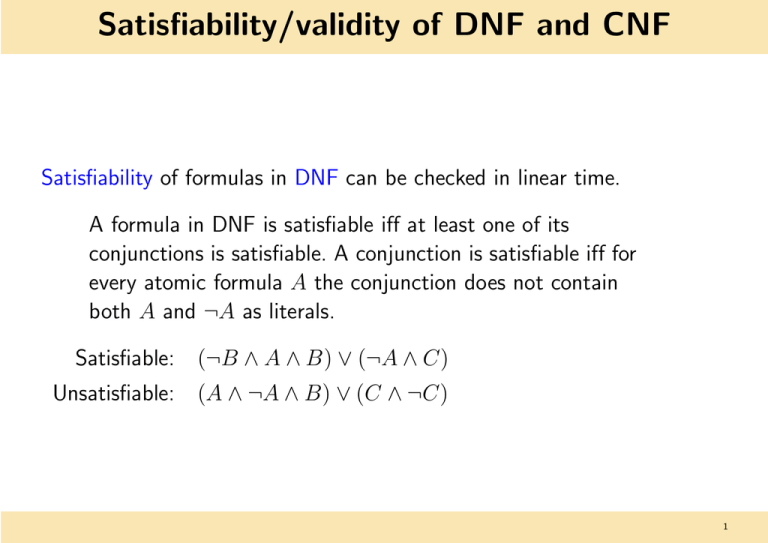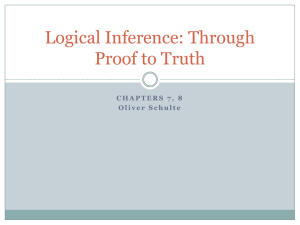Satisfiability/validity of DNF and CNF
advertisement

Satisfiability/validity of DNF and CNF
Satisfiability of formulas in DNF can be checked in linear time.
A formula in DNF is satisfiable iff at least one of its
conjunctions is satisfiable. A conjunction is satisfiable iff for
every atomic formula A the conjunction does not contain
both A and ¬A as literals.
Satisfiable:
(¬B ∧ A ∧ B) ∨ (¬A ∧ C)
Unsatisfiable:
(A ∧ ¬A ∧ B) ∨ (C ∧ ¬C)
1
Satisfiability/validity of DNF and CNF
Validity of formulas in CNF can be checked in linear time.
A formula in CNF is valid iff all its disjunctions are valid.
A disjunction is valid iff for some atomic formula A the
disjunction contains both A and ¬A as literals (or the
disjunction is empty.)
Valid:
(A ∨ ¬A ∨ B) ∧ (C ∨ ¬C)
Not valid: (A ∨ ¬A) ∧ (¬A ∨ C)
2
Satisfiability/validity of DNF and CNF
Theorem: Satisfiability of formulas in CNF is NP-complete.
Theorem: Validity of formulas in DNF is NP-complete.
3
Efficient satisfiability checks
In the following:
• A very efficient satisfiability check for the special class of
Horn formulas.
• Efficient satisfiability checks for arbitrary formulas in CNF:
DPLL, resolution.
4
Horn formulas
A formula F in CNF is a Horn formula if every disjunction in F
contains at most one positive literal.
Notation:
(¬A ∨ ¬B ∨ C) becomes (A ∧ B → C)
(¬A ∨ ¬B) becomes (A ∧ B → 0)
A becomes (1 → A)
5
Satisfiablity check for Horn formulas
Input: a Horn formula F .
for every atomic formula A occurring in F do
if F has a subformula of the form (1 → A)
then mark every occurrence of A in F
while F has a subformula G of the form
do
A1 ∧ . . . ∧ Ak → B or A1 ∧ . . . ∧ Ak → 0
and A1 , . . . , Ak are already marked
and B is not yet marked
if G has the first form then mark every occurrence of B
else return “unsatisfiable” and halt
return “satisfiable” and halt
6
Correctness of the marking algorithm
Theorem. The marking algorithm is correct and halts after at most n
iterations of the while loop, where n is the number of atomic
formulas that occur in F .
Proof: (a) Termination: after n iterations all atomic formulas are
marked, and so the loop condition does not hold.
(b) If “unsatisfiable” then unsatisfiable.
Observe: if the algorithm marks A, then A(A) = 1 for every
assignment A such that A(F ) = 1.
Assume A(A) = 1 for some A. Let (A1 ∧ . . . ∧ An → 0) be the
subformula causing “unsatisfiable”. Since A1 , . . . Ak are marked,
A(A1 ) = . . . = A(Ak ) = 1. Then A(A1 ∧ . . . ∧ Ak → 0) = 0 and so
A(F ) = 0, contradiction. So F has no satisfying assignments.
7
(c) If “satisfiable” then satisfiable.
We show that the assignment given by
A(Ai ) = 1 iff Ai is marked after termination
satisfies F :
• In every (A1 ∧ . . . ∧ Ak → B) either B is marked or at least one
Ai is not marked.
• In every (A1 ∧ . . . ∧ Ak → 0) at least one Ai is not marked
(otherwise the algorithm would have terminated with
“unsatisfiable”).
8
Runtime
Let n be the number of atomic formulas in F .
Let m be the length of F .
Step (1) can be executed in O(nm) time (at most two scans of the
formula for each variable).
The number of iterations of the while loop is bounded by n, and the
runtime of an iteration is bounded by m.
Overall runtime: O(nm).
In the next slides we sketch a faster O(m) algorithm.
9
An O(m) algorithm
Data structure:
• Array of conjuncts, each conjunct stored as a list.
(e.g., A1 ∧ A2 → B stored as A1 7→ A2 7→ B)
• Array of size n, where the i-th element is a list of pointers to all
occurrences of Ai on left-hand-sides of conjuncts.
• Single-linked list W of length at most n to store the variables
that have been marked but not yet processed.
• Bitvector V of length n to store the variables that have been
marked.
10
An O(m) algorithm
1, O(m)
1. W, V = {A | 1 → A is conjunct of F }
2. while W 6= ∅
n, O(n)
3.
pick (and delete) A from W
n, O(n)
4.
for each conjunct G → H s.t. A occurs in G do
5.
delete A from G
O(m), O(m)
6.
if G is empty then
O(m), O(m)
7.
if H = B and B ∈
/ V then add B to W, V O(m), O(m)
8.
else /*H = 0*/ return “unsatisfiable”
1, O(1)
9. return “satisfiable”
1, O(1)
For each line we give the number of times it is executed and the total
time required by all executions together.
11
An O(m) algorithm
Correctness argument (informal):
The algorithm mimics the original one. Marking an atomic formula
corresponds to adding it to the worklist.
12
Example: MYCIN
MYCIN: Rule system for treatment of blood infections developed in
the 1970s.
Beispiel:
IF the infection is pimary-bacteremia
AND the site of the culture is one of the
sterile sites
AND the suspected portal of entry is the
gastrointestinal tract
THEN there is suggestive evidence (0.7) that
infection is bacteroid.
13

